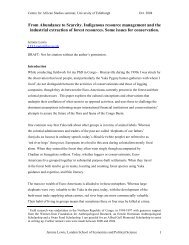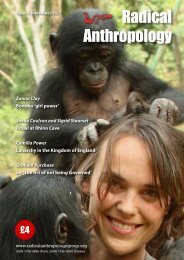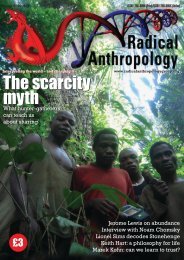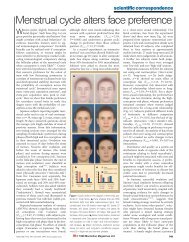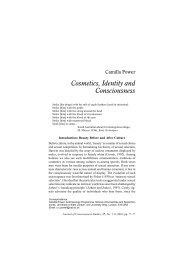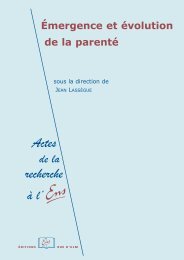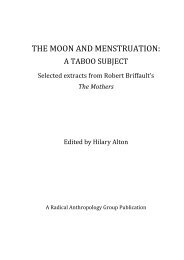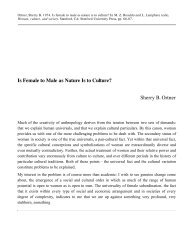Language and life history: A new perspective on the development ...
Language and life history: A new perspective on the development ...
Language and life history: A new perspective on the development ...
- No tags were found...
Create successful ePaper yourself
Turn your PDF publications into a flip-book with our unique Google optimized e-Paper software.
Commentary/Locke & Bogin: <str<strong>on</strong>g>Language</str<strong>on</strong>g> <str<strong>on</strong>g>and</str<strong>on</strong>g> <str<strong>on</strong>g>life</str<strong>on</strong>g> <str<strong>on</strong>g>history</str<strong>on</strong>g>first <str<strong>on</strong>g>and</str<strong>on</strong>g> grammar bootstrapped off it. There is evidence that here<strong>on</strong>togeny also may recapitulate phylogeny (Peters 1983; W<strong>on</strong>gFillmore 1976).In terms of mental storage <str<strong>on</strong>g>and</str<strong>on</strong>g> retrieval it is also clear that atleast some of <strong>the</strong> phrasal lexic<strong>on</strong> <str<strong>on</strong>g>and</str<strong>on</strong>g> that part of <strong>the</strong> <strong>on</strong>e-wordlexic<strong>on</strong> which has associated c<strong>on</strong>diti<strong>on</strong>s of use are right hemispherical,whereas analytic <str<strong>on</strong>g>and</str<strong>on</strong>g> syn<strong>the</strong>tic linguistic capacitiesare generally left hemispherical (Van Lancker 1987; Wray 2002).From crying to words: Unique or multilevelselective pressures?Daniela Lenti Boero a <str<strong>on</strong>g>and</str<strong>on</strong>g> Luciana Bott<strong>on</strong>i ba Corso di laurea in Scienze Psicologiche e delle Relazi<strong>on</strong>i di Aiuto, Universitéde la Vallée d’Aoste, 11110 Aosta. Italy; b Dipartimento di Scienzedell’Ambiente e del Territorio, Università degli Studi Milano Bicocca, 20126Milan, Italyd.lentiboero@univda.it luciana.bott<strong>on</strong>i@unimib.ithttp://www.disat.unimib.it/bioacousticsAbstract: In <strong>the</strong> first year of <str<strong>on</strong>g>life</str<strong>on</strong>g>, infants’ utterances change from highintensitycrying to low-intensity acoustic sound strings, acousticallylabelling <strong>the</strong> first word. This transiti<strong>on</strong> implies: (1) decoding ofph<strong>on</strong>etic sounds, (2) encoding of ph<strong>on</strong>etic sounds, <str<strong>on</strong>g>and</str<strong>on</strong>g> (3) a uniquelinking of an articulated sound to a specific object. Comparative,<strong>on</strong>togenetic, <str<strong>on</strong>g>and</str<strong>on</strong>g> phylogenetic aspects are c<strong>on</strong>sidered for multilevelselective pressures.In <strong>the</strong> first year of <str<strong>on</strong>g>life</str<strong>on</strong>g>, a human infant’s sound emissi<strong>on</strong> changesfrom crying, a high-intensity mammalian signal (Lenti Boero1997), to low-intensity sound strings having a referentialmeaning (i.e., words). Semantics comes earlier in <strong>on</strong>togenythan grammar <str<strong>on</strong>g>and</str<strong>on</strong>g> syntax, <str<strong>on</strong>g>and</str<strong>on</strong>g> c<strong>on</strong>stitutes <strong>the</strong> bricks <strong>on</strong> whichsubsequent language competence is built. Between <strong>the</strong> twoextremes of high-intensity crying <str<strong>on</strong>g>and</str<strong>on</strong>g> low-intensity speech, wefind early sound making: a pleasant, musical, rewarding signalfor both infant <str<strong>on</strong>g>and</str<strong>on</strong>g> mo<strong>the</strong>r (de Boyss<strong>on</strong>-Bardie 2001; Papoušek& Papoušek 1981; Ruzza et al. 2003). The transiti<strong>on</strong> from earlycrying to <strong>the</strong> first meaningful word implies <strong>the</strong> existence of <strong>the</strong>following competencies:1. Decoding of ph<strong>on</strong>etic sounds (perceptual)2. Encoding of ph<strong>on</strong>etic sounds (articulati<strong>on</strong> <str<strong>on</strong>g>and</str<strong>on</strong>g> motor)3. Linking univocally an articulated sound to a specific object(cognitive).It is important to underscore that language includes both perceptualdecoding <str<strong>on</strong>g>and</str<strong>on</strong>g> motor encoding comp<strong>on</strong>ents, as earliestclinical studies by Broca <str<strong>on</strong>g>and</str<strong>on</strong>g> Wernicke showed (Ellis & Young1988).<str<strong>on</strong>g>Language</str<strong>on</strong>g> <strong>on</strong>togeny in <strong>the</strong> first year of <str<strong>on</strong>g>life</str<strong>on</strong>g> implies separatedecoding <str<strong>on</strong>g>and</str<strong>on</strong>g> encoding competencies. In human communicati<strong>on</strong>artefacts (e.g., human communicati<strong>on</strong> engineered products, liketeleph<strong>on</strong>es, where, in <strong>the</strong> same object, both encoding <str<strong>on</strong>g>and</str<strong>on</strong>g> decodingdevices are designed at <strong>the</strong> same time by <strong>the</strong> human maker[who is not blind]) decoding <str<strong>on</strong>g>and</str<strong>on</strong>g> encoding features coevolve,but this might not be <strong>the</strong> same for language. (It is importantto c<strong>on</strong>trast human design <str<strong>on</strong>g>and</str<strong>on</strong>g> natural selecti<strong>on</strong>’s design, <str<strong>on</strong>g>and</str<strong>on</strong>g>underscore <strong>the</strong> independence of decoding <str<strong>on</strong>g>and</str<strong>on</strong>g> encodinglanguage features.) In fact, <strong>the</strong> above-menti<strong>on</strong>ed threecompetencies might have different selective pressures.Referential competence is defined as <strong>the</strong> ability to identifyobjects by means of an ic<strong>on</strong> (acoustic or visual). Earlier studies<strong>on</strong> apes’ language have shown that even <strong>the</strong> nearest apescannot articulate human-like sounds because of <strong>the</strong> lack ofarticulati<strong>on</strong> space <str<strong>on</strong>g>and</str<strong>on</strong>g> nervous motor c<strong>on</strong>trol of <strong>the</strong> larynx(Lieberman et al. 1969; Ploog 1992); however, apes are very competentin referring objects to tokens or human gestures. O<strong>the</strong>rmammals have been shown to utter species-specific soundsrelated to predators (Cheney & Seyfarth 1990; Lenti Boero1992), to underst<str<strong>on</strong>g>and</str<strong>on</strong>g> human words relative to objects (Kaminskiet al. 2004), <str<strong>on</strong>g>and</str<strong>on</strong>g> to discriminate ph<strong>on</strong>etic sounds (Miller 1977;Morse & Snowd<strong>on</strong> 1975). Thus, from mammalian studies wededuce that competencies 1 <str<strong>on</strong>g>and</str<strong>on</strong>g> 3 are present (many moreexamples can be given), but competency 2 is lacking.Studies <strong>on</strong> s<strong>on</strong>gbirds have proposed that <strong>the</strong>y should be c<strong>on</strong>sideredinteresting models for human language because of<strong>the</strong>ir ability to articulate strings of sounds <str<strong>on</strong>g>and</str<strong>on</strong>g> to crystallizespecies-specific s<strong>on</strong>gs heard in <strong>the</strong> social envir<strong>on</strong>ment, aprocess similar to <strong>the</strong> <strong>on</strong>e that human infants undergo in <strong>the</strong>transiti<strong>on</strong> from crying, through early sound making, to correctarticulati<strong>on</strong> of <strong>the</strong> first word (Hultsch & Todt 2004).S<strong>on</strong>gbirds have competencies 1 <str<strong>on</strong>g>and</str<strong>on</strong>g> 2, but completely lack competency3. Am<strong>on</strong>g birds, parrots (in particular, <strong>the</strong> Gray parrot)are a unique species in this respect, having, like humans, allthree competencies (Pepperberg 1981; 1983). However, competency3 is used <strong>on</strong>ly in animal-human interacti<strong>on</strong>s, analogouslyas am<strong>on</strong>g apes, suggesting that parrots <str<strong>on</strong>g>and</str<strong>on</strong>g> apes do not sp<strong>on</strong>taneouslygenerate socially shared referential systems – apparentlya unique human competency (but see Savage-Rumbaughet al. 1996). If all those competencies appear separately am<strong>on</strong>gvertebrates, <strong>the</strong>y must have different selective pressures.In <strong>the</strong> first m<strong>on</strong>th of <str<strong>on</strong>g>life</str<strong>on</strong>g>, <strong>the</strong> human infant shows competency1 (Mehler et al. 1988), but does not show competency 2. (Ifproper experiments have not yet been d<strong>on</strong>e to explore competency3, <strong>the</strong>se will certainly come later <strong>on</strong>.) Did competency 1undergo selective pressure, <str<strong>on</strong>g>and</str<strong>on</strong>g>, if so, from which agents?Percepti<strong>on</strong> <str<strong>on</strong>g>and</str<strong>on</strong>g> discriminati<strong>on</strong> of ph<strong>on</strong>etic sounds cannot beearly selected by parents, being c<strong>on</strong>cealed to <strong>the</strong>m, <str<strong>on</strong>g>and</str<strong>on</strong>g> can bedisclosed <strong>on</strong>ly with proper experiments <str<strong>on</strong>g>and</str<strong>on</strong>g> selected for if <str<strong>on</strong>g>and</str<strong>on</strong>g><strong>on</strong>ly if eventually related to fur<strong>the</strong>r sounds <str<strong>on</strong>g>and</str<strong>on</strong>g> babblingemissi<strong>on</strong>.The above-menti<strong>on</strong>ed studies <strong>on</strong> s<strong>on</strong>g learning in s<strong>on</strong>gbirdssuggest <strong>the</strong> existence in a vertebrate species of an inner motorlearning module, expressing itself in future phases. In humans,<strong>the</strong> full expressi<strong>on</strong> of native language sounds might be postp<strong>on</strong>edby <strong>the</strong> immaturity of <strong>the</strong> articulati<strong>on</strong> <str<strong>on</strong>g>and</str<strong>on</strong>g> nervous motor c<strong>on</strong>trolcomp<strong>on</strong>ent. If percepti<strong>on</strong> <str<strong>on</strong>g>and</str<strong>on</strong>g> discriminati<strong>on</strong> of ph<strong>on</strong>etic soundsdo not relate to later sound-making <str<strong>on</strong>g>and</str<strong>on</strong>g> babbling, we shouldthink of selective pressures independent from parental selecti<strong>on</strong>.One possibility is that those competencies are a by-product of amore widespread <str<strong>on</strong>g>and</str<strong>on</strong>g> general cognitive module referring toanalysis of acoustic scene performed in <strong>the</strong> natural envir<strong>on</strong>ment.The fact that o<strong>the</strong>r mammalian <str<strong>on</strong>g>and</str<strong>on</strong>g> bird species are able to discriminatehuman ph<strong>on</strong>etic sounds, <str<strong>on</strong>g>and</str<strong>on</strong>g> that Gray parrots are ableto decode <str<strong>on</strong>g>and</str<strong>on</strong>g> discriminate musical notes from <strong>the</strong> temperatescale, might support this hypo<strong>the</strong>sis (Bott<strong>on</strong>i et al. 2004). Withregard to competency 2, it is important to underscore thathumans are <strong>the</strong> <strong>on</strong>ly mammalian species endowed with an articulati<strong>on</strong>apparatus allowing <strong>the</strong> emissi<strong>on</strong> of quasi-musical soundsthat, as Locke & Bogin (L&B) correctly state, have been selectedby parental pressures. This apparatus is <strong>the</strong> foundati<strong>on</strong> of vowelemissi<strong>on</strong> (Titze 1994), <str<strong>on</strong>g>and</str<strong>on</strong>g>, toge<strong>the</strong>r with an improved (in respectto apes) t<strong>on</strong>gue <str<strong>on</strong>g>and</str<strong>on</strong>g> buccal c<strong>on</strong>trol, it lies behind <strong>the</strong> abilityto articulate early music-like sounds <str<strong>on</strong>g>and</str<strong>on</strong>g> more refined laterph<strong>on</strong>etic sounds.This articulati<strong>on</strong> process is allowed by <strong>the</strong> descent of larynx in<strong>the</strong> neck, losing c<strong>on</strong>tact with <strong>the</strong> naso-pharynx (we are uniqueam<strong>on</strong>gst mammalian species in this regard). In order to underst<str<strong>on</strong>g>and</str<strong>on</strong>g>human language as we know it, a key point should be toquesti<strong>on</strong> how <str<strong>on</strong>g>and</str<strong>on</strong>g> why this happened. Camperio Ciani <str<strong>on</strong>g>and</str<strong>on</strong>g>Chiarelli (1988), investigating <strong>the</strong> physiology of b<strong>on</strong>e depositi<strong>on</strong><str<strong>on</strong>g>and</str<strong>on</strong>g> reallocati<strong>on</strong> process in <strong>the</strong> cranium during <strong>on</strong>togeny, suggestthat larynx descent is a by-product of <strong>the</strong> systemic morphofuncti<strong>on</strong>aladjustments to include a large prefr<strong>on</strong>tal cortex in <strong>the</strong>braincase. In <strong>the</strong> course of hominid phylogeny, larynx descentshould have happened gradually; we might speculate of anhominid phase during which vocal communicati<strong>on</strong> was nol<strong>on</strong>ger built of fixed mammalian-like sounds but was not yet292 BEHAVIORAL AND BRAIN SCIENCES (2006) 29:3



